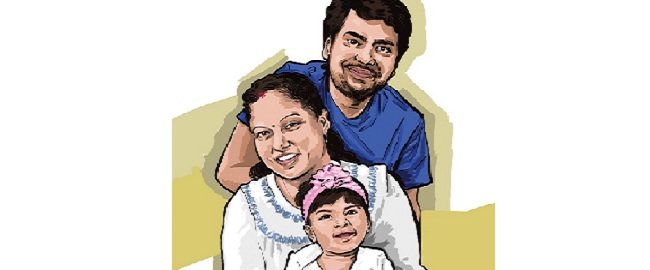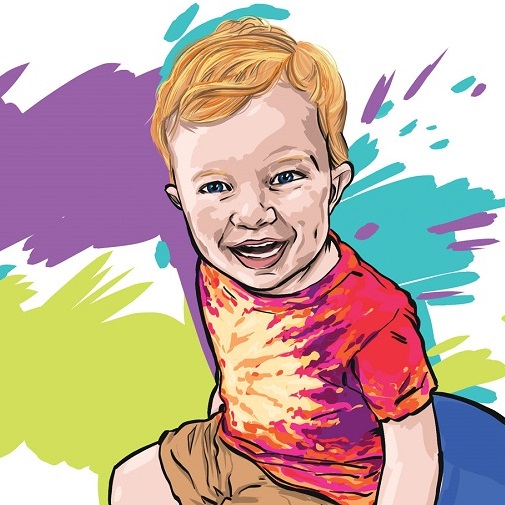COVID-19 and Cerebral Palsy

October 16, 2020
Typically, we photograph every patient appearing in HealthU. Because this story was planned during the surge of COVID-19, that contact would have been too risky. Instead, our team took a creative approach and replaced photo shoots with illustrated portraits of patients.
Zoey Komninos has a distinct giggle. A high-pitched laugh, it’s almost like she’s yelling in your ear, says her mom, Melanie Komninos. Zoey, 15, has severe cerebral palsy. Although she can’t speak, she is most definitely expressive.
“She’ll smile, she’ll babble, she’ll listen to others,” Melanie says. “She will give her two cents by interrupting. You can tell when she’s paying attention.”
Zoey also has a seizure disorder as well as ongoing upper-respiratory issues. So when the Komninoses received a call in mid-March that one of Zoey’s home nurses had been exposed to COVID-19, the family acted fast. On March 19,
Zoey went to the Pediatric Emergency Department at Joseph M. Sanzari Children’s Hospital at Hackensack University Medical Center, where she ultimately tested positive for COVID-19. Once admitted, she didn’t leave the hospital for 25 days.
Braving the Unknown
As much as we still have to learn about COVID-19 today, in March doctors and researchers knew much less, says Felicia Gliksman, D.O., pediatric neurologist at the Children’s Hospital. “We really didn’t know what was going to happen,” she says. Even the scant research that existed didn’t necessarily pertain to Zoey’s specific medical conditions.
One of the medical team’s goals was to give Zoey the best possible respiratory support. Eventually, she was in too much distress and had to be intubated and placed on a mechanical ventilator. To tolerate this degree of respiratory support, she required sedation and paralysis, commonly known as a medically induced coma. Knowing that Zoey tends to seize more when she’s sick, doctors hooked her up to a continuous electroencephalogram (EEG)—a test to evaluate the electrical activity in the brain—to look for seizures because she couldn’t shake or twitch as a result of the paralysis.
One of the most difficult parts of treating COVID-19—at least for now—is that there isn’t a cure-all drug, says Rachel Lewis, M.D., a pediatric critical care medicine specialist. “We have to be patient, support the patient’s breathing, let the virus run its course and deal with problems as they arise,” she says.
For Zoey, daily treatment included making sure she was breathing well on the ventilator and turning her side to side so she didn’t develop pressure ulcers. The team also had to make sure she tolerated her formula feeds and suction anything that came out of her breathing tube.
But more than anything, treatment was about time. “That’s probably the hardest part,” Dr. Lewis says, “especially for parents.”
Family Comfort
No one understands this waiting more than Melanie. Zoey’s has had her share of long hospital stays before. But in the past, Melanie and her husband, Jimmy, would take shifts staying in the hospital. That wasn’t possible with COVID-19. To minimize the chance of spread, once Melanie entered the room, she couldn’t leave. So Melanie stayed with Zoey, while Jimmy remained at home looking after their other two kids.
Melanie wore a mask for three weeks straight, even while she was sleeping. “I try to keep very positive,” she says. “But when people offered their sympathies or support, when they were asking specific questions about Zoey, you get emotional. And those masks and tears don’t mix.”
The hospital did all they could to make Melanie feel comfortable. They brought her a personal coffee maker and provided meals and clothes for her to wear. Zoey was in the epilepsy monitoring unit, which has an additional bed and bathroom with a shower.
Another barrier remained: So much of pediatric care is a continuous connection with the family, a stream of talking and providing updates. But the hospital staff had to don new masks and gowns every time they entered Zoey’s room, limiting the human interaction that can help ease such difficult moments.
Care in the time of COVID-19 is about improvising, so the nurses, doctors and respiratory therapists learned to write backward—medical notes, well-wishes—on the clear glass of patient rooms. Dr. Lewis bought a bunch of magnetized wipe-off markers so others could leave notes, too. Soon, the windows filled up with supportive messages, such as notes saying that Zoey was a rock star. “Even nurses who didn’t know her would come to the window to write ‘hello,’” Melanie says.
The staff was always concerned about how Zoey was doing. “It’s like our home away from home when we’re there,” Melanie says. “I wouldn’t want to be anywhere else. When their shift ended, their concern didn’t. Doctors would call me to check on how Zoey and I were doing.”
Home Sweet Home
Zoey was sedated for two weeks, with the team taking a cautious approach to removing the ventilator. “My biggest concern was that I couldn’t predict what would happen when I took her breathing tube out,” Dr. Lewis says.
Kids with neurologic disorders may not always be able to clear their airways, and what’s in their mouth can trickle down into their lungs. The breathing tube was protecting that airway. “I was just hoping she would wake up,” Melanie says. “That was scary. I was just wanting her to be alert.”
What followed went far better than anyone could have predicted—not just in taking the tube out, but in the subsequent weeks. Melanie and Zoey returned home, and then something happened that was as amazing as her recovery from COVID-19, Dr. Gliksman says.
During a follow-up telehealth visit, Zoey was more alert and vocal than ever. “Someone who was critically ill for as long as she was could have had residual cognitive issues, taking a while to get back to their baseline,” Dr. Gliksman says. “But it was the most active that I’ve seen her. I was just so amazed at how well she looked.”
Melanie has seen just how vocal Zoey’s been, too: “It’s so refreshing and heartwarming to see her happy and engaged.”
Next Steps & Resources:
- Meet our sources: Rachel Lewis, M.D. and Felicia Gliksman, D.O.
- To make an appointment with Dr. Lewis, Dr. Gliksman or another doctor near you, call 800-822-8905 or visit our website.
- How COVID-19 affects kids
- Kids and masks
The material provided through HealthU is intended to be used as general information only and should not replace the advice of your physician. Always consult your physician for individual care.
Jersey City Toddler Plagued by Seizures Is Now Seizure-free

On July 6, 2019, Shanaya Sinha was born in Charlotte, North Carolina. She was healthy and beautiful and brought unimaginable joy to her mother, Sukriti, 32, and father, Alok, 35.
Edison Doctor Treats Rare Craniosynostosis in Infant Girl
When Layla Maloney was born in June 2020, the back of her head was a little flat, a common condition called plagiocephaly.

3-Year-Old Now Seizure-Free
After 18 hours of labor, an almost-10-pound Braydin was delivered via cesarean section, and for a while, seemed healthy.

A Recipe for Success
From the NICU to neurosurgery to speech therapy – this 5-year-old boy found all the ingredients he needed to thrive.
